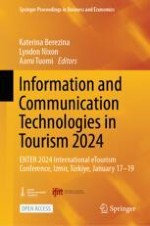1 Background
2 Purpose of the Study
3 Review of AI-Based Technologies and Application Areas
AI-based DL Technology | Type | Generic Application Areas | Application to Tourism |
|---|---|---|---|
Convolutional Neural Network An algorithm specifically designed for image processing and recognition tasks | Computer Vision | Image & facial recognition; medical image analysis; voice recognition; automatic sign language recognition | Secure registration at borders and check-ins, temporary ownership, purchase authorizations |
Style Transfer A computer vision and graphics technique to combine the content of one image with the visual style of another | Computer vision, graphics | Transferring or superimposing famous artistic styles to user-supplied images | Deep localization in marketing communications |
Deep Learning Based Recommender System An application that is based on multiple DL technologies, and uses an algorithm to suggest choices of interest based on Big Data | Ranking | Suggesting consumer products based on past purchases or browsing histories; personalized list of choices; preference predictions (Amazon, Spotify, etc.) | Personalized itineraries, authenticated reviews |
Generative Adversarial Network A type of learning architecture that pits two neural networks against each other to generate new synthetic data in close resemblance to an existing data distribution | Generative AI | Generating examples for image datasets, such as human faces or realistic photographs, image-to-image, text-to-image, or semantic-image-to-photo translations, video prediction (such as Memoji creation in iPhones) | Personalized interactive ads; tangibilization of future experiences |
Variational Autoencoder An algorithm to generate new content while detecting & removing noise | Generative AI | Image morphing; image reconstruction; outlier detection | Event simulations, accuracy in recreational programming |
Recurrent Neural Network An algorithm that operates on sequential data to predict new outcomes | Sequential data processing | Language translation; natural language processing (NLP); speech recognition & image captioning; (e.g., Alexa, Google Translate) | Polylingual tour guiding; universal translators; accessible, anti-ableist visitor experiences |
Graph Neural Networks (GNN) | Solve problems related to graph-structured data | Networks that can be represented via graph. Some examples are social networks, molecular structures, and transportation networks | Tourist flow prediction |
